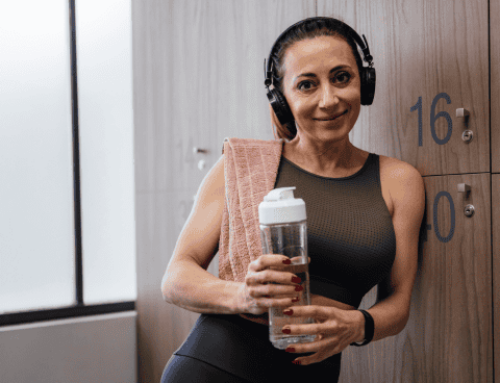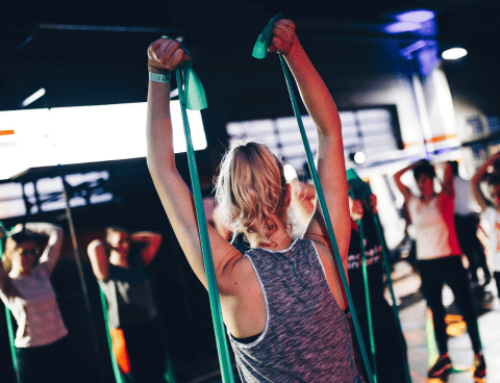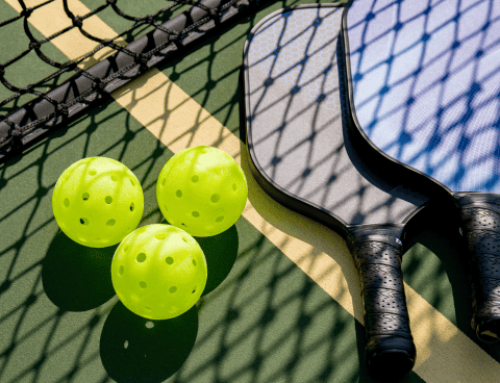Workout Upgrades to Get You to the Next Level
Feel like you’re doing the same thing at the gym every week? If so, you need a workout upgrade—and you’re not alone. It’s quite common for athletes to fall into a rut. Often, they’re uncomfortable trying something new for fear it will hurt their performance.
Good habits are important to success, but it can be beneficial to challenge yourself with something new. If you add these five workout upgrades to your usual routine, you should be on your way to setting personal bests.
Get Dense
If you don’t use a foam roll to start your workout, you’re behind the curve. Benefits include improved range of motion and muscular performance.
If you use the foam roll and feel it doesn’t work the knots out like it used to, you may be ready for a denser object to perform self-myofascial release. You have two options: a neoprene-covered PVC pipe or a tennis or lacrosse ball.
The small ball may be easiest to use. It offers more focused soft-tissue work to break up adhesions and decrease tension in the muscles of your glutes, calves, feet, posterior shoulders and pecs.
Some people prefer the PVC roller, though, because it’s similar in size and shape to the foam roller. For more information on this, head here: PVC Roller.
Throw Stuff Against the Wall
Throwing a medicine ball is athletic, period. You quickly create force with your legs before transferring it through your stable core and into an upper body throwing motion. It’s a perfect example of the kinetic chain sequencing necessary for sports, and it incorporates the entire body with each movement. In addition, medicine ball throws are a fun addition to any strength and conditioning program. I can’t think of many better ways to take out my frustration than throwing a medicine ball against a wall!
Most of the time, we have our athletes perform transverse-plane medicine ball exercises, which are a great complement to the usual sagittal plane-dominant strength and conditioning routines. Try some of these exercises to start: Medicine Ball Throws.
With more advanced athletes, we incorporate progressions that mimic patterns used in sports, such as footwork, hip turn and weight-shift variations.
Get Quick
Most athletes focus entirely too much on top speed and too little on acceleration. The ability to accelerate separates the great players from the good ones. Watch your favorite sport and tell me how often the best players on the field or court reach full speed. Usually, they spend more time accelerating than running at top speed. When you realize this and start to train appropriately, it will be a difference-maker.
When training acceleration with my athletes, I use a combination of start variations (as seen here) and good old-fashioned Box Pushes. With Box Pushes, I make sure the athletes emphasize the marching pattern and forward shin angle seen during acceleration. It is extremely important that they use this marching pattern to reinforce full stride length, instead of taking short, choppy steps. We want to apply maximal force into the ground and not just “spin our wheels.”
Also, with our more advanced athletes, we add resistance to the movement by placing weight on top of the boxes.
Add the “Anti-“
This is probably a new concept for many of you, but next time you go to the gym, I want you to look at the core movements you are currently doing or that others are doing. What is one thing many of these movements have in common? They all produce motion.
Although it is important for the body to produce motion through the trunk, it is equally important to have the ability to resist motion. Enter anti-extension and anti-rotation movements.
In the athletic community, these types of movements have become more prevalent, especially since a growing body of evidence supports the need for a stable core with athletic movement.
Typically, I start my athletes on anti-extension exercises because I want them to own the sagittal plane first. I instruct them to lock their rib cage to their pelvis and to limit their range of motion if their rib cage rises and their low back goes into lordosis (i.e., abnormal forward curvature ). For an introduction to anti-extension-based exercise, try the Body Saw.
Single-Leg Variety
Have you ever seen a sport where the athletes play the entire competition with both feet on the ground in a shoulder-width stance? I didn’t think so. Yet when you look at many strength-training programs, you see they are full of symmetrical-stance exercises like the Clean, Squat and Deadlift. I am not saying these are bad exercises. I am saying if they are the only exercises you do for your legs, you are missing the big picture.
Athletic movement typically consists of smooth and efficient moves from one leg to the other. When an athlete runs at full speed, he produces and controls roughly four times his body weight through one leg. If he is unable to control and produce force through that leg, he will either be left behind or get injured. So how do we train for that? By adding more single-leg variations to our workouts.
I typically break down the single-leg variations into single leg hip-dominant exercises (Single Leg Deadlift or Bowler Squat) and single-leg quad-dominant exercises (Single Leg Squat or Pistol Squat).
RECOMMENDED FOR YOU
MOST POPULAR
Workout Upgrades to Get You to the Next Level
Feel like you’re doing the same thing at the gym every week? If so, you need a workout upgrade—and you’re not alone. It’s quite common for athletes to fall into a rut. Often, they’re uncomfortable trying something new for fear it will hurt their performance.
Good habits are important to success, but it can be beneficial to challenge yourself with something new. If you add these five workout upgrades to your usual routine, you should be on your way to setting personal bests.
Get Dense
If you don’t use a foam roll to start your workout, you’re behind the curve. Benefits include improved range of motion and muscular performance.
If you use the foam roll and feel it doesn’t work the knots out like it used to, you may be ready for a denser object to perform self-myofascial release. You have two options: a neoprene-covered PVC pipe or a tennis or lacrosse ball.
The small ball may be easiest to use. It offers more focused soft-tissue work to break up adhesions and decrease tension in the muscles of your glutes, calves, feet, posterior shoulders and pecs.
Some people prefer the PVC roller, though, because it’s similar in size and shape to the foam roller. For more information on this, head here: PVC Roller.
Throw Stuff Against the Wall
Throwing a medicine ball is athletic, period. You quickly create force with your legs before transferring it through your stable core and into an upper body throwing motion. It’s a perfect example of the kinetic chain sequencing necessary for sports, and it incorporates the entire body with each movement. In addition, medicine ball throws are a fun addition to any strength and conditioning program. I can’t think of many better ways to take out my frustration than throwing a medicine ball against a wall!
Most of the time, we have our athletes perform transverse-plane medicine ball exercises, which are a great complement to the usual sagittal plane-dominant strength and conditioning routines. Try some of these exercises to start: Medicine Ball Throws.
With more advanced athletes, we incorporate progressions that mimic patterns used in sports, such as footwork, hip turn and weight-shift variations.
Get Quick
Most athletes focus entirely too much on top speed and too little on acceleration. The ability to accelerate separates the great players from the good ones. Watch your favorite sport and tell me how often the best players on the field or court reach full speed. Usually, they spend more time accelerating than running at top speed. When you realize this and start to train appropriately, it will be a difference-maker.
When training acceleration with my athletes, I use a combination of start variations (as seen here) and good old-fashioned Box Pushes. With Box Pushes, I make sure the athletes emphasize the marching pattern and forward shin angle seen during acceleration. It is extremely important that they use this marching pattern to reinforce full stride length, instead of taking short, choppy steps. We want to apply maximal force into the ground and not just “spin our wheels.”
Also, with our more advanced athletes, we add resistance to the movement by placing weight on top of the boxes.
Add the “Anti-“
This is probably a new concept for many of you, but next time you go to the gym, I want you to look at the core movements you are currently doing or that others are doing. What is one thing many of these movements have in common? They all produce motion.
Although it is important for the body to produce motion through the trunk, it is equally important to have the ability to resist motion. Enter anti-extension and anti-rotation movements.
In the athletic community, these types of movements have become more prevalent, especially since a growing body of evidence supports the need for a stable core with athletic movement.
Typically, I start my athletes on anti-extension exercises because I want them to own the sagittal plane first. I instruct them to lock their rib cage to their pelvis and to limit their range of motion if their rib cage rises and their low back goes into lordosis (i.e., abnormal forward curvature ). For an introduction to anti-extension-based exercise, try the Body Saw.
Single-Leg Variety
Have you ever seen a sport where the athletes play the entire competition with both feet on the ground in a shoulder-width stance? I didn’t think so. Yet when you look at many strength-training programs, you see they are full of symmetrical-stance exercises like the Clean, Squat and Deadlift. I am not saying these are bad exercises. I am saying if they are the only exercises you do for your legs, you are missing the big picture.
Athletic movement typically consists of smooth and efficient moves from one leg to the other. When an athlete runs at full speed, he produces and controls roughly four times his body weight through one leg. If he is unable to control and produce force through that leg, he will either be left behind or get injured. So how do we train for that? By adding more single-leg variations to our workouts.
I typically break down the single-leg variations into single leg hip-dominant exercises (Single Leg Deadlift or Bowler Squat) and single-leg quad-dominant exercises (Single Leg Squat or Pistol Squat).
[cf]skyword_tracking_tag[/cf]











